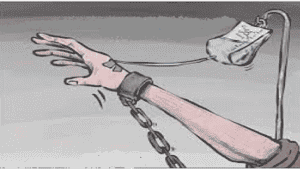by Jason Tarnow | Sep 2, 2020 | Crime, Criminal Attorney, Legal Rights, Media, Police, Politics, Social Media, Uncategorized
In one of our previous posts, we discussed biometric technology and the role it plays in Canadian law enforcement. It is, however, only one of the “predictive” tools utilized by the police in relation to criminal investigations.
A new report by the Citizen Lab at the University of Toronto goes into alarming detail regarding growth of algorithmic policing methods, and how this technology compromises the privacy rights of Canadian citizens. The report is incredibly thorough and comprehensive, delving into how this controversial technique offends various sections of our Canadian Charter of Rights and Freedoms. Firstly, though, it is important that our readers understand what algorithmic policing is.

The overall success of any algorithm is the system’s ability to gather, store, and analyze data – with law enforcement’s methodology being no different. A “location focused” algorithmic approach seeks to determine (predict) which areas are more likely to see criminal activity. The algorithmic system in these pursuits analyzes historical police data to identify geographical locations where crimes are, in theory, more likely to be committed. If this sounds familiar to you, then you’ve likely heard of, or accessed, the Vancouver Police Department’s GeoDash crime map – an online tool where you can navigate a map of the City of Vancouver by crime occurrence. You can choose from a variety of offences on the dropdown list, including homicide, break and enter, mischief, theft, and “offences against a person” which likely includes a variety of crimes such as sexual assault, assault causing bodily harm, and uttering threats. By looking at this map, you get an idea of which neighborhoods in Vancouver are most vulnerable to crime – except that it’s a little bit more sophisticated than that, and goes far beyond simply dropping a pin on the map. The public can see where the crime took place, but not who is alleged to have committed it. The offender’s personal information is logged, in as much detail as possible, and becomes part of a larger system dedicated to predictive surveillance – i.e., it creates a profile of which individuals are more likely to commit a particular crime. This profile can be used to identify people who are “more likely to be involved in potential criminal activity, or to assess an identified person for their purported risk of engaging in criminal activity in the future”.

While this information is definitely concerning, there is another issue: we have very little insight into the extent that this technology is being used. We know that the methods by which police gather information have historically discriminated against minority groups and those living in marginalized communities. This seems to guarantee that the VPD’s use of algorithmic investigative techniques relies on data that is often obtained through biased methods. We know that black and indigenous individuals are disproportionately represented in the correctional system, which can only mean that they are disproportionately represented in respect of these algorithms.
Although not everyone agrees that systemic racism exists within the VPD, the calls to address, unravel and mitigate the harm to marginalized groups continue to amplify. The idea that information collected under the apprehension of bias will not only remain on record, but will be used to further future investigations, is an indicator that Canadian law enforcement’s road to redemption will likely be a bumpy one.
by Jason Tarnow | Jul 2, 2020 | Crime, Criminal Attorney, Legal Rights, Media, Police, Riots, Social Media, Wheels Of Justice
Over the last couple of months, there has been outcry from the public urging the use of BWC’s (Body Worn Cameras) for Canadian law enforcement. Although initially in response to the growing unrest relating to police brutality in the United States, there are echoes of abandoned intentions from Canadian officials dating back at least a few years.
Back in 2015, the Office of the Privacy Commissioner of Canada (“OPCC”) issued a publication regarding the use of BWC by police, in collaboration with privacy agencies in Alberta, New Brunswick and Quebec. The remaining Canadian law enforcement agencies from other provinces and territories acted “in consultation”.
For reference: according to the CBC, there were a total of 2 incidents involving the death of individuals at the hands of law enforcement in New Brunswick between 2012 and 2014, 12 incidents in Quebec, and 14 incidents in Alberta. Interestingly enough, British Columbia (on par with Quebec at 14 deaths) and Ontario (with the highest rate of police violence resulting in death in the country at 25 deaths between 2012 and 2014) were only acting in consultation.
The report hails the effectiveness of BWC to capture high quality images, videos, and audio recordings – so effective, in fact, that the OPCC had grave concerns regarding their ability to capture material that could jeopardize the privacy of innocent and uninvolved bystanders.

The report goes on to tout the value of BWC for evidentiary purposes, including analytics so sophisticated that the material obtained would likely be suitable for biometric comparison – aka, facial recognition.
There is no arguing the fact that the use of BWC by police has implications for the privacy of citizens in their everyday lives – especially since once fitted, citizens would likely expect on-duty officers to have their devices on a continuous basis as opposed to intermittently.
Benefits of BWC include the ability to review interactions between police and the public, recording communications between the police and suspects in the course of an investigation, identifying potential witnesses, and of course recording interactions between police officers. Many criminal cases involve evidence obtained through the use of dash cams, which provide audio from inside a police cruiser and video from the perspective of the driver. The effectiveness of this technology loses value when the investigation takes place outside of a police vehicle, as the audio often fails to capture intelligible communications between police and a suspect, or between officers themselves. Although the dash cam is kept running, the audio portion is often useless when the interactions between police and a suspect take place outside the vehicle, and the windows of the police cruiser are closed, or if the police/suspect leave the immediate area where the audio is successfully captured.
The report indicates that while continuous recording would undoubtedly provide a greater level of accountability for the actions of police, the threat to personal privacy reigns supreme:
“From an accountability perspective, continuous recording may be preferable because it captures an unedited recording of an officer’s actions and the officer cannot be accused of manipulating recordings for his or her own benefit. However, from a privacy perspective, collecting less or no personal information is always the preferred option”
In 2014, the Edmonton Police concluded a pilot project regarding the use of BWC by its officers. The conclusion?:
“The cameras had no effect on police use-of-force incidents and said there was no statistical difference in resolving police complaints”
According to an analysis done by CBC, there were a total of four deaths between 2012 and 2014 relating to officers of the Edmonton Police Service. By comparison, there were 9 deaths in the same period relating to officers of the Toronto Police Service. The results of the Pilot Project may have seen different results in a different jurisdiction.
The Edmonton Police explained that in addition to being ineffective to expose cases of police misconduct, the related expenses were simply unrealistic. Perhaps surprisingly, it’s not the cost of the devices themselves, but the expense to store and manage all of the material collected: somewhere between 6 and 15 million dollars over five years, which also includes hiring personnel qualified for the job.
Finding the balance between accountability, transparency and oversight of police against the protection of privacy for Canadian citizens is a legitimate and profound task – one that cannot be taken lightly. As the calls for BWC in Canadian law enforcement grow louder, and as Canadians revisit the reality of what it is to be privileged in this country, we can only hope that the values of dignity and equality are recognized as being more valuable than the cost of the equipment that very well could save lives.
by Jason Tarnow | May 12, 2020 | Crime, Criminal Attorney, Legal Aid, Legal Rights, Media, Riots, Social Media
On March 18, 2020, the BC court system responded to the coronavirus pandemic swiftly and without hesitation, reducing operations by the likes of which criminal counsel simply hasn’t seen before. Once it was confirmed how rapidly COVID19 spreads, the crowded confines of publicly accessed courtrooms were immediately deemed inappropriate – dangerous even. Since courtrooms often yield a congregation of some of society’s most vulnerable people, it made perfect sense to act defensively. These decisions, and many others effecting the justice system, were made only one week after the World Health Organization declared a global pandemic on March 11, 2020.
Unfortunately, there was a noticeable absence of urgency when it came time to protect the vulnerable inmate population overcrowded and totally confined within the walls of Mission Institution.
“In the worst-case scenario, CSC will need to order more body bags and find cold storage to stack up the bodies of those whose lives will be lost that could have been saved” – Justin Piche, criminologist, Criminalization and Punishment Project at the University of Ottawa
On March 31, 2020, federal Public Safety Minister Bill Blair recommended that the Correctional Service of Canada (“CSC”) immediately consider the release of non-violent inmates to mitigate the unavoidable reality that the virus could, and would, devastate the wellbeing of prison populations. His recommendation came on the heels of the CSC announcing the first two positive COVID-19 cases in federal institutions in Quebec.

On April 4, 2020, the CSC announced 4 confirmed cases at Mission Institution, leading to a lockdown of the facility.
By April 8, 2020, there were 11 confirmed cases, all inmates. Nearly one month had passed since the WHO declared a global pandemic.
By April 18, 60 inmates and 10 staff tested positive, and the CSC marked its first coronavirus related inmate death, exactly one month after the courts effectively shut down.
By April 25, 2020, 106 inmates and 12 correctional officers were confirmed to be infected, representing the largest outbreak in the Canadian Correctional System. On this date, the CSC advised that all inmates at Mission Medium Institution had been tested, but in any event, new cases were continuing to be discovered.
While disturbing, none of these developments are surprising. The largest incidence of outbreaks has been at long-term care homes – combining close quarters, limited mobility, and care-workers employed at more than one facility is a recipe for disaster when it comes to COVID-19, a pathogen that spreads and infects without discrimination. The same vulnerabilities exist within the correctional system, where they are intensified. Inmates and corrections staff are simply unable to practice crucial social distancing. Personal protective equipment for inmates has not been prioritized as it has in other sectors, despite these individuals being at a much higher risk of getting sick.

The CSC responded to COVID-19 by prohibiting visits to inmates, temporary absences, work releases, and inmate transfers between correctional facilities. While these steps likely helped to curb the spread of the virus, as a whole, they are grossly inadequate. Without a vaccine, social distancing remains our greatest defence against the virus. For the inmates at Mission Institution and those incarcerated at facilities across Canada, proper protective equipment is hard to come by, but hope is even harder.
by Jason Tarnow | Apr 21, 2020 | Crime, Criminal Attorney, Legal Aid, Legal Rights, Media, Politics, Uncategorized, Wheels Of Justice
It has been over one month since the Courts of British Columbia significantly curtailed operations in an attempt to combat COVID-19.

For many of those who work in the legal field, it was this development that made it all real. It quickly became clear that the novel coronavirus had the potential to spread quickly, and the confined space of a courtroom serves as ideal grounds for transmission.
Despite the coronavirus acting as a proverbial wrench in the gears of justice, the judicial system continues to putter along. This is largely due to increased utilization of technological tools like video/conferencing for court appearances and swearing of affidavits, and relaxing restrictions when it comes to fax/electronic filing of court documents.
Video conferencing isn’t new to the BC court system. As early as 2002, Judges across the province agreed that the technology improved procedural efficiency by facilitating witness testimony from distant locations and allowing interim appearances by video involving counsel from other jurisdictions. Judges also noted the value of video- conferencing for inmates at correctional centres – defeating the purpose of transferring multiple inmates from various correctional centres to various courthouses. The bottom line is that modernizing certain aspects of the criminal justice system makes sense financially and systemically – and events like COVID-19 demonstrate how it can have occupational benefits too.
At present, there is enormous value in modernizing certain judicial processes for two reasons – one, to limit face-to-face interactions between judicial staff, defence counsel and an Accused person, and two, to mitigate the consequences of what can only be described as colossal delay.
In reducing operations, the majority of criminal trials scheduled between March 18, 2020 and June 1, 2020, have been adjourned generally to dates in June and July, 2020. Cases that are deemed to be of an urgent nature will be able to proceed, although in a procedural sense, things will look different – for example, witnesses who would ordinarily appear before the Court to give evidence may be authorized to testify via video. For the most part, however, trials will proceed at a date that is likely much later than originally anticipated.

The situation is more grim for accused persons in custody awaiting their trial. Inmates are, of course, among the most vulnerable to contracting the novl coronavirus – a concern that was a topic of discussion before the courts closed – but didn’t really become part of the actual narrative until it was too late Trials for accused persons in custody have also been adjourned (for trials scheduled between March 23 and May 16, 2020). Sentencing hearings and bail hearings for accused persons will proceed. This could be positive – for some, it might result in their immediate release from the correctional system. For others, further incarceration for as little as an additional 90 days in custody will be devastating, a potential death sentence.
It is far too early to gauge how overwhelmed the court system will be at the return to business as usual – but when you consider that there was a huge backlog before COVID-19 shut it all down, it seems only reasonable that extreme measures – such as implementing night/weekend court, and permanently authorizing certain modernization measures – will need to be taken to truly return to normal.
by Jason Tarnow | Mar 5, 2020 | Crime, Criminal Attorney, Legal Aid, Police, Social Media, Wheels Of Justice
“No person is criminally responsible for an act committed or an omission made while suffering from a mental disorder that rendered the person incapable of appreciating the nature and quality of the act or omission or of knowing that it was wrong”

He was a student and Captain of Mount Royal University’s hockey team – but that changed on January 13, 2018, after taking a large dose of magic mushrooms.
Shortly after ingesting 4 grams of mushrooms at a house party, Matthew Brown took off all of his clothing and disappeared into the freezing night. Eventually, he came upon the home of a Mount Royal University professor that he had never met before. He broke into her home and beat her with a broken broom handle, leaving her with severe injuries. After leaving her residence, he broke into another home where he was eventually apprehended by the police.
On March 2, 2020, he was acquitted after mounting a successful defence of “non-insane automatism” resulting from severe self-intoxication.
Mr. Brown was acquitted and walked out of court a free man. His actions were found to be involuntary – but not by reason of mental disorder. His defence of non-insane automatism resulting from severe self-intoxication was only available after a pre-trial ruling in which a judge found that Section 33.1 of the Criminal Code, prohibiting self-intoxication as a defence, was unconstitutional.
Non-insane automatism and insane automatism both involve an Accused person that was unaware of the consequences of their actions at the time of the offence, and therefore could not form intent required to prosecute the offence.
In Mr. Brown’s case, his automatism ended when the effects of the drugs wore off, and he was left with no memory of the event. Since his actions were not attributed to a disease that would have recurring symptoms, a Not Criminally Responsible according to Mental Disorder (NCRMD) finding would have been inappropriate.
 A finding of NCRMD relates to automatism as a consequence of a mental disorder. Unlike automatism resulting from intoxication, it does not result in an acquittal. NCRMD is most commonly seen in cases where an Accused suffers from severe mental illness, such as schizophrenia. Across Canada, the number of Accused deemed NCRMD is small, however, media attention on these particular cases often results in public outrage.
A finding of NCRMD relates to automatism as a consequence of a mental disorder. Unlike automatism resulting from intoxication, it does not result in an acquittal. NCRMD is most commonly seen in cases where an Accused suffers from severe mental illness, such as schizophrenia. Across Canada, the number of Accused deemed NCRMD is small, however, media attention on these particular cases often results in public outrage.
After a judge has determined that an Accused is NCRMD, the case is usually handed over to the Review Board (governed by Province/Territory) where there are three possible outcomes:
- Absolute Discharge
- Conditional Discharge
- Detention in a hospital
While most cases do end up under the authority of the Review Board, the Court of hearing has the discretion to proceed to disposition if it feels appropriate in the circumstances. If the Court orders an Absolute Discharge (the only available option when the Accused has been found not to pose a significant risk to the public), the matter is concluded. If the Court orders a conditional discharge, or detention in a hospital, the Review Board must review the matter again with 90 days. In any circumstance, the Court or Review Board must impose whichever sentence is the least onerous and least restrictive on the Accused, all while balancing protection of the public and the interests, liberty and dignity of the Accused. There have been success stories, (which may again cause unnecessary alarm to the public) that demonstrate how effective rehabilitation of mentally ill offenders is far from hopeless. It is also important to note that the statistics surrounding NCRMD cases show that the prevalence of an NCRMD finding in relation to violent offences are low.









 A finding of NCRMD relates to automatism as a consequence of a mental disorder. Unlike automatism resulting from intoxication, it does not result in an acquittal. NCRMD is most commonly seen in cases where an Accused suffers from severe mental illness, such as schizophrenia. Across Canada, the number of Accused deemed NCRMD is small, however, media attention on these particular cases often results in public outrage.
A finding of NCRMD relates to automatism as a consequence of a mental disorder. Unlike automatism resulting from intoxication, it does not result in an acquittal. NCRMD is most commonly seen in cases where an Accused suffers from severe mental illness, such as schizophrenia. Across Canada, the number of Accused deemed NCRMD is small, however, media attention on these particular cases often results in public outrage.